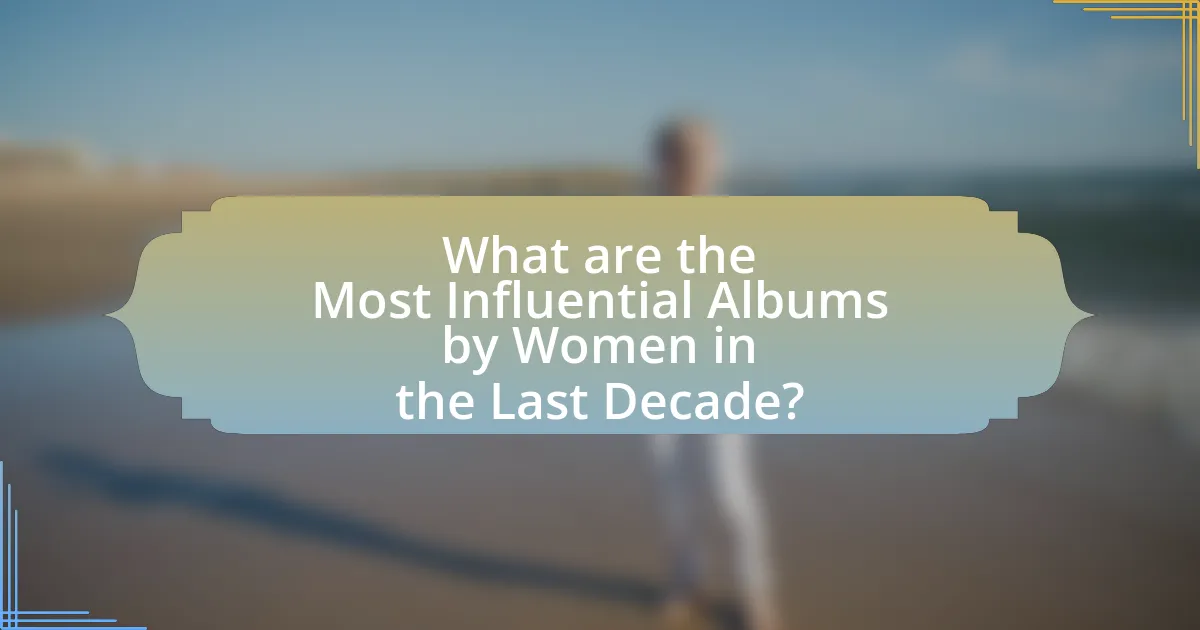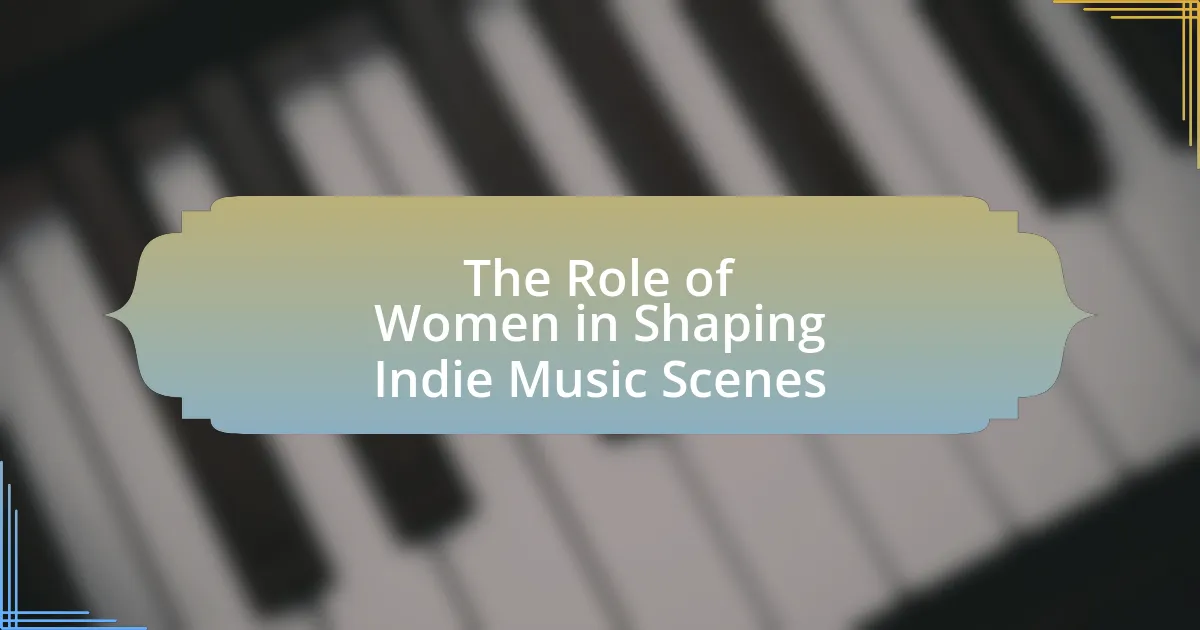The article reviews the most influential albums by women in the last decade, highlighting key works such as “Lemonade” by Beyoncé, “25” by Adele, “Norman Fucking Rockwell!” by Lana Del Rey, “Future Nostalgia” by Dua Lipa, and “Folklore” by Taylor Swift. It examines how these albums have shaped the music industry by redefining genre boundaries, promoting women’s voices, and addressing themes of empowerment, identity, and social justice. The article also discusses the barriers women face in the music industry, their influence on future generations, and the importance of recognizing their contributions to foster a more inclusive landscape. Additionally, it explores emerging trends and artists that are likely to shape the future of women in music.

What are the Most Influential Albums by Women in the Last Decade?
The most influential albums by women in the last decade include “Lemonade” by Beyoncé, “25” by Adele, “Norman Fucking Rockwell!” by Lana Del Rey, “Future Nostalgia” by Dua Lipa, and “Folklore” by Taylor Swift. “Lemonade,” released in 2016, received critical acclaim for its exploration of race, feminism, and personal identity, earning a Grammy Award for Best Urban Contemporary Album. Adele’s “25,” released in 2015, became one of the best-selling albums of all time, showcasing her powerful vocal ability and emotional depth. Lana Del Rey’s “Norman Fucking Rockwell!” (2019) was praised for its lyrical sophistication and cultural commentary, solidifying her status as a significant artist. Dua Lipa’s “Future Nostalgia” (2020) revitalized pop music with its disco influences and strong themes of empowerment, while Taylor Swift’s “Folklore” (2020) marked a shift to indie-folk, receiving widespread acclaim for its storytelling and introspective lyrics. Each of these albums has significantly impacted the music industry and culture, reflecting the diverse experiences and artistry of women in music.
How have these albums shaped the music industry?
These albums have significantly shaped the music industry by redefining genre boundaries and elevating women’s voices in a male-dominated space. For instance, albums like “Lemonade” by Beyoncé and “Future Nostalgia” by Dua Lipa have not only achieved commercial success but also sparked conversations around social issues, empowerment, and identity. The impact is evident in the increased representation of women in various genres, as seen in the rise of female-led collaborations and the prioritization of diverse narratives in mainstream music. Additionally, these albums have influenced industry standards, leading to more inclusive practices in music production and marketing, as evidenced by the Grammy Awards’ growing recognition of female artists.
What themes are prevalent in these influential albums?
Influential albums by women in the last decade often explore themes of empowerment, identity, and social justice. For instance, albums like Beyoncé’s “Lemonade” delve into personal and collective experiences of race and feminism, while Billie Eilish’s “When We All Fall Asleep, Where Do We Go?” addresses mental health and existential questions. Additionally, Taylor Swift’s “Folklore” and “Evermore” reflect themes of storytelling and introspection, showcasing the complexities of relationships and personal growth. These thematic elements resonate widely, reflecting contemporary societal issues and personal narratives that connect with diverse audiences.
How do these albums reflect societal changes?
These albums reflect societal changes by addressing themes such as gender equality, mental health, and social justice, which resonate with contemporary issues. For instance, albums like Beyoncé’s “Lemonade” confront racial and gender identity, highlighting the struggles faced by Black women in America, while Billie Eilish’s “When We All Fall Asleep, Where Do We Go?” explores mental health challenges, reflecting a growing societal awareness and dialogue around mental health issues. Additionally, Taylor Swift’s “Lover” promotes LGBTQ+ acceptance, showcasing the shift towards inclusivity in mainstream culture. These thematic explorations in the albums mirror the evolving societal landscape, where artists use their platforms to advocate for change and reflect the voices of marginalized communities.
Why is it important to recognize women in music?
Recognizing women in music is important because it highlights their significant contributions to the industry and promotes gender equality. Women have historically faced barriers in the music industry, yet they have produced influential works that shape genres and inspire future artists. For instance, in the last decade, albums by women such as Beyoncé’s “Lemonade” and Taylor Swift’s “Folklore” have not only achieved commercial success but also received critical acclaim, showcasing the artistic depth and cultural impact of female musicians. Acknowledging these contributions fosters a more inclusive music landscape and encourages the next generation of female artists to pursue their passions.
What barriers have women faced in the music industry?
Women in the music industry have faced significant barriers including gender discrimination, lack of representation, and unequal pay. Gender discrimination manifests in various forms, such as being overlooked for opportunities, receiving less promotion, and facing stereotypes that question their musical abilities. According to a 2020 report by the Annenberg Inclusion Initiative, women comprised only 21.6% of artists in popular music, highlighting the lack of representation. Additionally, women often earn less than their male counterparts; a study by the Music Industry Research Association found that female musicians earn approximately 30% less than male musicians. These barriers contribute to a challenging environment for women striving for success in the music industry.
How have women artists influenced future generations?
Women artists have significantly influenced future generations by challenging societal norms and expanding the boundaries of artistic expression. For instance, artists like Beyoncé and Taylor Swift have used their platforms to address issues such as feminism, mental health, and social justice, inspiring young artists to incorporate activism into their work. Additionally, the rise of genres like indie pop and alternative rock, led by women such as Billie Eilish and Halsey, has encouraged a new wave of musicians to explore personal and vulnerable themes in their music. This shift is evidenced by the increasing number of female artists topping charts and receiving critical acclaim, demonstrating their lasting impact on the music industry and cultural landscape.

Which Albums Stand Out as the Most Influential?
The albums that stand out as the most influential by women in the last decade include “Lemonade” by Beyoncé, “1989” by Taylor Swift, and “When We All Fall Asleep, Where Do We Go?” by Billie Eilish. “Lemonade,” released in 2016, is notable for its exploration of race, feminism, and personal identity, receiving critical acclaim and sparking discussions on social issues. Taylor Swift’s “1989,” released in 2014, marked her transition from country to pop, influencing the music industry and setting new standards for album marketing and storytelling. Billie Eilish’s “When We All Fall Asleep, Where Do We Go?” from 2019 redefined pop music with its unique sound and themes of mental health, resonating with a younger audience and earning multiple Grammy Awards. These albums have not only shaped the careers of their artists but also impacted cultural conversations and the music landscape significantly.
What criteria define an album’s influence?
An album’s influence is defined by its cultural impact, critical reception, and commercial success. Cultural impact refers to how the album shapes or reflects societal trends, movements, or conversations, such as how Beyoncé’s “Lemonade” addressed issues of race and feminism. Critical reception involves the acclaim and recognition an album receives from music critics and industry awards, exemplified by Taylor Swift’s “Folklore,” which garnered multiple Grammy Awards. Commercial success is measured by sales figures, chart performance, and streaming numbers, as seen with Adele’s “21,” which became one of the best-selling albums of all time. These criteria collectively illustrate an album’s significance in the music landscape and its lasting legacy.
How do sales and chart performance contribute to influence?
Sales and chart performance significantly contribute to influence by establishing an artist’s commercial success and visibility in the music industry. High sales figures indicate strong consumer demand, while chart performance reflects an album’s popularity and reach among listeners. For instance, albums that achieve top positions on charts like the Billboard 200 often gain increased media attention and critical acclaim, further enhancing the artist’s influence. Additionally, data from the Recording Industry Association of America (RIAA) shows that albums with higher sales tend to have a lasting impact on cultural trends and music styles, reinforcing the connection between commercial success and influence in the industry.
What role does critical acclaim play in determining influence?
Critical acclaim significantly enhances an artist’s influence by validating their work and increasing visibility within the industry. When albums receive positive reviews from reputable critics, it often leads to greater media attention, higher sales, and increased streaming numbers. For instance, albums like Beyoncé’s “Lemonade” and Taylor Swift’s “Folklore” garnered widespread critical praise, which not only solidified their artistic credibility but also expanded their cultural impact, influencing trends and inspiring other artists. This correlation between critical acclaim and influence is evident in the way successful albums often dominate award nominations and shape public discourse, further establishing the artist’s role in the music landscape.
Who are the key artists behind these influential albums?
The key artists behind the influential albums in the last decade include Taylor Swift, Beyoncé, Adele, Billie Eilish, and Lizzo. Taylor Swift’s “Folklore” and “Evermore” redefined pop and indie genres, while Beyoncé’s “Lemonade” addressed themes of race and feminism. Adele’s “25” showcased powerful ballads, and Billie Eilish’s “When We All Fall Asleep, Where Do We Go?” introduced a unique sound in pop music. Lizzo’s “Cuz I Love You” celebrated body positivity and self-love. Each of these artists has significantly impacted the music landscape, contributing to cultural conversations and pushing artistic boundaries.
What unique styles do these artists bring to their music?
These artists bring diverse styles to their music, characterized by innovative blends of genres and personal storytelling. For example, Billie Eilish incorporates elements of pop, electronic, and alternative music, creating a sound that is both haunting and introspective, as evidenced by her album “When We All Fall Asleep, Where Do We Go?” which topped charts globally. Similarly, Lizzo combines pop, hip-hop, and soul, promoting messages of self-love and empowerment, particularly in her hit album “Cuz I Love You,” which received critical acclaim and multiple Grammy nominations. Additionally, Taylor Swift’s transition from country to pop, especially in her album “1989,” showcases her ability to reinvent her sound while maintaining lyrical depth, resulting in significant commercial success. Each artist’s unique style not only reflects their personal experiences but also resonates with a wide audience, contributing to their influence in the music industry over the last decade.
How have these artists evolved over the last decade?
Over the last decade, artists have evolved by diversifying their musical styles, embracing new technologies, and addressing social issues in their work. For instance, artists like Taylor Swift transitioned from country to pop and indie-folk, showcasing versatility and experimentation with genres. Similarly, Billie Eilish emerged with a unique sound that blends pop, electronic, and alternative influences, reflecting contemporary themes of mental health and identity. Additionally, the rise of streaming platforms has allowed artists to reach wider audiences and experiment with shorter album formats, as seen in the works of artists like Lizzo and H.E.R., who incorporate elements of hip-hop, R&B, and soul. This evolution is evidenced by the increased recognition of women in music, with numerous Grammy wins and nominations highlighting their impact on the industry.

What Impact Have These Albums Had on Culture?
These albums have significantly shaped contemporary culture by challenging societal norms and empowering marginalized voices. For instance, albums like Beyoncé’s “Lemonade” and Taylor Swift’s “Folklore” have sparked discussions on race, feminism, and mental health, influencing public discourse and inspiring movements such as Black Lives Matter. Additionally, these works have redefined genre boundaries, blending pop, R&B, and folk, which has encouraged greater diversity in music production and consumption. The cultural impact is evidenced by their critical acclaim, chart-topping success, and the way they resonate with listeners, reflecting and shaping the zeitgeist of the last decade.
How have these albums influenced popular culture?
These albums have significantly influenced popular culture by reshaping musical genres, promoting social movements, and redefining female representation in the music industry. For instance, albums like Beyoncé’s “Lemonade” not only blended various musical styles but also addressed themes of race, feminism, and infidelity, sparking widespread discussions and inspiring movements such as Black Lives Matter. Similarly, Taylor Swift’s “1989” marked a shift in country-pop crossover, influencing countless artists and altering the landscape of mainstream music. Additionally, Billie Eilish’s “When We All Fall Asleep, Where Do We Go?” challenged conventional pop aesthetics and themes, resonating with younger audiences and altering the expectations of pop music. These examples illustrate how these influential albums have left a lasting impact on cultural conversations and the music industry.
What collaborations or movements have emerged from these albums?
Collaborations and movements that have emerged from influential albums by women in the last decade include the rise of feminist music collectives and cross-genre partnerships. Notably, albums like Beyoncé’s “Lemonade” sparked the Black feminist movement in music, leading to collaborations with artists like Jack White and Kendrick Lamar, which emphasized social justice themes. Additionally, Taylor Swift’s “Lover” fostered a wave of LGBTQ+ advocacy through partnerships with artists like Brendon Urie, promoting inclusivity in pop music. These collaborations reflect a broader cultural movement towards empowerment and representation in the music industry.
How do these albums resonate with different demographics?
These albums resonate with different demographics by addressing diverse themes and experiences that appeal to various age groups, cultural backgrounds, and social identities. For instance, albums like “Lemonade” by Beyoncé connect deeply with younger audiences through themes of empowerment and racial identity, while older listeners may appreciate the nostalgic elements in Taylor Swift’s “Folklore,” which reflects on personal growth and relationships. Additionally, the incorporation of genres such as pop, R&B, and hip-hop allows these albums to reach a wide audience, as evidenced by the commercial success and critical acclaim across different listener segments, including the Billboard charts, which show varied demographic engagement.
What lessons can be learned from these influential albums?
Influential albums by women in the last decade teach the importance of authenticity and self-expression in music. These albums often reflect personal experiences and societal issues, demonstrating how vulnerability can resonate with audiences. For instance, albums like “Lemonade” by Beyoncé address themes of race, infidelity, and empowerment, showcasing the power of storytelling in music. Additionally, artists like Taylor Swift have illustrated the evolution of narrative songwriting, emphasizing the impact of personal growth and resilience. These lessons highlight that music can serve as a platform for social change and personal reflection, encouraging listeners to embrace their own narratives.
How can aspiring artists draw inspiration from these works?
Aspiring artists can draw inspiration from these works by analyzing the innovative techniques and themes presented in the influential albums created by women over the last decade. For instance, artists can study how Billie Eilish’s use of minimalism in “When We All Fall Asleep, Where Do We Go?” revolutionized pop music production, encouraging a focus on emotional authenticity and personal storytelling. Additionally, examining the lyrical depth and social commentary in albums like Beyoncé’s “Lemonade” can inspire artists to address complex societal issues through their own art. These examples demonstrate that engaging with the creative processes and messages of these albums can lead to new artistic directions and personal growth.
What strategies can be adopted to promote women in music?
To promote women in music, strategies such as increasing visibility through dedicated platforms, mentorship programs, and equitable funding opportunities can be adopted. Increasing visibility can involve creating female-focused music festivals and awards that highlight women’s contributions, as seen with initiatives like the Women’s Music Summit. Mentorship programs can connect emerging female artists with established musicians, fostering growth and collaboration, similar to the success of organizations like She Is The Music. Additionally, equitable funding opportunities can ensure that women receive fair access to resources, as evidenced by studies showing that female artists often receive less funding than their male counterparts. These strategies collectively aim to create a more inclusive and supportive environment for women in the music industry.
What are the Future Trends for Women in Music?
Future trends for women in music include increased representation in leadership roles, a rise in genre diversity, and the use of technology for creative expression. Women are increasingly taking on executive positions in record labels and music organizations, which fosters a more inclusive industry. Additionally, women are exploring various genres beyond traditional pop, such as hip-hop, rock, and electronic music, reflecting a broader range of artistic expression. The integration of technology, including social media and music production software, allows women to produce and distribute their music independently, enhancing their visibility and reach. These trends are supported by statistics showing that female artists are gaining more chart success and recognition in major award shows, indicating a shift towards greater equality in the music industry.
How might the landscape of women in music change in the next decade?
The landscape of women in music is likely to become more diverse and influential in the next decade, driven by increased representation and support for female artists. Data from the Annenberg Inclusion Initiative indicates that women accounted for only 21.6% of artists in popular music from 2012 to 2019, but initiatives promoting gender equity in the industry are gaining momentum. Organizations like She Is The Music and the Women’s Audio Mission are actively working to create opportunities for women, which could lead to a significant rise in female-led projects and collaborations. Furthermore, the growing popularity of genres like pop and hip-hop, where women are increasingly taking the lead, suggests that the next decade will see more women not only as performers but also as producers, songwriters, and executives, reshaping the industry landscape.
What emerging artists should we watch for in the future?
Emerging artists to watch for in the future include Olivia Rodrigo, who gained significant attention with her debut album “SOUR,” which topped charts and received critical acclaim. Another notable artist is Arlo Parks, whose debut album “Collapsed In Sunbeams” won the Brit Award for Best New Artist and showcases her unique blend of poetry and music. Additionally, girl in red, known for her relatable lyrics and DIY approach, has rapidly gained a dedicated following and critical recognition. These artists are shaping the future of music, evidenced by their impactful releases and growing fan bases.





